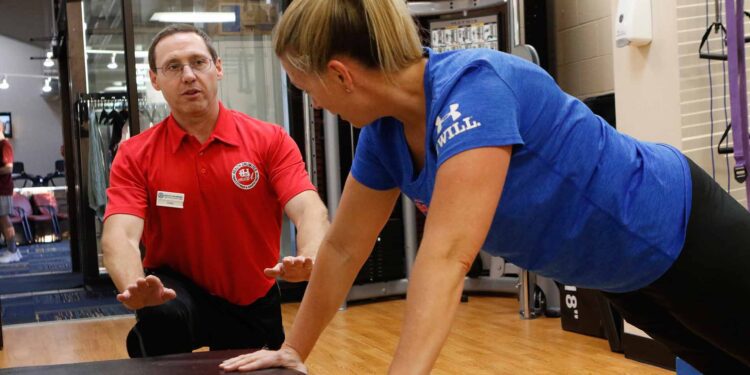by Linda Esterson, photography by Bill Ryan
It’s that time of year again — time to stuff ourselves silly with holiday goodies and then, as the New Year approaches, think about how on earth to drop the pounds and get healthy. Studies find that fewer than 25 percent of people actually stay committed to their New Year’s resolutions after just 30 days, and only 8 percent accomplish them. Experts suggest that for greater success, folks should set a goal rather than make a resolution. So set a goal to join a gym or hire a trainer, and read on to find out what might be the best option for you.
Box gyms
Whether referred to as a health club, box gym, fitness center or any combination, these large, open facilities with weights and cardio equipment are a popular option where members exercise in the same space, but on their own.
The gym setting, according to Clayton Arnold, co-owner of Gold’s Gym in Eldersburg, provides a sense of community as a place to find friends and comfort while working out. On-site staff is trained to be friendly and approachable, and are willing to offer assistance with operating equipment.
Arnold thinks he knows the reason many people don’t join a gym. “It’s not the price,” he says. “It’s that they’re scared of what happens inside the gym. The unknown can be scary to many people, especially if they’re already struggling with a weight issue or some type of health issue.”
Gym members like the flexibility of working out at times that fit their personal schedules. They aren’t tied to an appointment with a trainer or for a particular class. However, motivation is individual with a gym membership. Without a required appointment, there is no time commitment. That makes it easy to succumb to being tired, consent to an unexpected dinner invitation, or just not go.
“I tell people when they’re coming from work, ‘Don’t go home. You’re not coming back out,’” says Dan Strayton, owner of My Health Unlimited Family Fitness and Aquatic Center in Mt. Airy. “After sitting for 45 minutes in the car, they think, ‘I’ll just go home.’”
Strayton suggests gym workouts first thing in the morning, when there is no interference, or right after work, before other plans and children’s activities compete.
Cost is also a consideration with a gym membership. At Gold’s, membership is $22 per month. That includes use of all facilities, including gym, weight room, and basketball court. There’s no enrollment fee, no contract, and the membership commitment runs month-to-month.
Large group classes
As at many gyms, Gold’s membership includes unlimited participation in large group classes. The 38 class offerings consist of everything from BODYPUMP, a 60-minute strength training class in the weight room, to Zumba, a “fitness dance party,” to cycling, indoor biking with simulation. My Health Unlimited has a pool, so the facility adds classes like Aqua Zumba and Pumping H20 in the pool to its BODYPUMP, cycling, Zumba and yoga offerings.
“Group classes are a good way to know you’ve moved if you’re not sure what to do with the machines or how long to run,” says Arnold. “A 45-minute to an hour class is a mindless way to get a good workout.”
The larger classes, however, leave instructors little opportunity to provide individual attention, and an assumed level of fitness and exercise experience prevails in most class settings, says Cari Pierce, owner of Flip Yours Fitness & Wellness in Westminster.
“If you are someone with mobility issues or other physical limitations, there may not be enough oversight, modification, or variability to suit your body and its needs,” Pierce says. “A one-size — or limited scalability — offering does not suit all people.”
There’s also less of a financial stake if the classes are included in gym membership, she adds.
Personal training
Those preferring individual attention may choose personal training, as programs are tailored to meet personal goals like preparing for a race or getting stronger. Generally, certified trainers work at a gym or provide home visits, and clients work with trainers up to several times a week. An additional fee applies for 30- or 60-minute sessions, and the cost is based on commitment and frequency. My Health Unlimited fees fall on the lower end of the spectrum, Strayton says, at $45 per hour and $28 per half-hour. Some gyms charge as much as $75 for a full hour of training, depending on depth of the trainer’s educational background.
Trainers observe clients exercising and provide guidance to ensure technique is correct, Strayton says. They also work to challenge clients to work harder to ensure the greatest benefit of exercise. The workout often is more effective than someone simply exercising alone without being pushed to work harder and longer.
Small group training
Small group training provides a more affordable option, as participants receive instructor attention without having to pay for private, personal training, says Pierce, whose hybrid approach combines personal training and small group classes.
Clients benefit from a group discount. Group sessions at My Health Unlimited run $159 for 12 sessions of 40 minutes, or $13 each. Semi-private training at Flip Yours runs about $20 higher than single group class fees.
Arnold also owns CrossFit Execution, a high-level, class-based gym with free weights, dumbbells, kettle bells and functional equipment like treadmills, rowers and bicycles located next to Gold’s. The CrossFit method focuses on movement patterns based on human anatomy, like squatting, crawling, jumping and pushing, Arnold says. Highly trained coaches, most with advanced degrees, run the higher intensity training.
Small-group offerings can also focus on specific populations. Westminster Strength & Conditioning offers a strength program for women and taught by women, including Bryant’s wife, Angie, and a master’s program, for the over-50 population, which started two years ago.
The latter has proven life-changing, says owner Beau Bryant, who recalls celebrating an 88-year-old woman who deadlifted 88 pounds on her birthday, and a 70-year-old woman who had a stroke and was told she would never walk again who succeeded through barbell training to return to normal and deadlift almost 200 pounds. The programs aim to increase strength for individuals over age 30, who naturally experience a decline that impacts activities of daily living like carrying groceries and doing yardwork, Bryant says. Many of his clients are women over age 40 who “feel it sooner and recognize the need to be stronger” and are “scared to be part of a gym dominated by guys.”
The high-level programs carry a greater cost. At CrossFit, members pay $150 per month, but that fee also includes access to Gold’s Gym. The Westminster Strength & Conditioning programs run $125 per month for bi-weekly classes and full access to the gym and all of its offerings runs $175 per month.
The flexibility of individual training does not apply to group sessions, however. A set day and time is scheduled, and clients must appear at that designated time. On the contrary, though, having a set day and time blocked in the schedule, with like-minded participants, can serve as motivation.
Apps and home exercise
Home exercise dates back decades to the do-it-yourself audio and video cassettes from celebrity “experts” like Jane Fonda, Denise Austin, and Tony Little, and televised workouts from the likes of Richard Simmons. Others purchase their own fitness equipment like treadmills, ellipticals, stationary bicycles and weights to create a gym-like atmosphere at home without the need to go elsewhere and pay for a membership.
Those exercising at home can take advantage of mobile apps that track activity. MyFitnessPal, Fitbit and the Apple Watch not only enable the user to track exercise, but also to enjoy the social aspect of competing, comparing progress with friends and family members.
“You can do challenges with other people,” says Strayton. “You get motivation that you might get from a trainer through social media and apps.”
The cost for app exercise ranges from free to hundreds of dollars. Cellphones have built-in health apps that track steps, as does the Apple Watch, once the watch is connected to a data plan. The Fitbit app is free and can track with a cellphone as long the device is in a pocket. Buying a tracking device, however, can be costly — the Fitbit Versa 2 is $229.95 online, and the Apple Watch Series 5 starts at $399.
Apps, however, don’t include the camaraderie of working out at a gym or being in a class with others. Having an app might show an individual he has lost two pounds, but announcing it to a full gym and having the crowd erupt is much more meaningful.
“You need an extra push, whether it’s a class, a trainer or executive training,” says Arnold. “Doing it on your own — our society is not motivated to do that anymore. We want you to feel so good when you leave class that you have to come back.”













